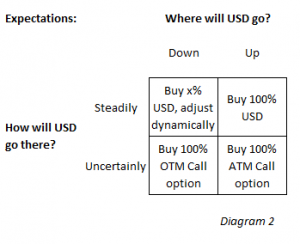Financiële markt in Egypte
| 12-09-2016 | René Schilder |
 Afgelopen weken hebben er verschillende artikelen in de internationale kranten gestaan over de lening die het IMF aan Egypte wil verstrekken. Daarbij zagen we ook de Egyptische minister van landbouw Nederland bezoeken om te leren van de Nederlandse expertise op het gebied van land- en tuinbouw. De ontwikkelingen op de financiële markt in Egypte krijgen ook meer aandacht, dus we kunnen concluderen dat het interessant is om even stil te staan hoe de lokale valuta daar is georganiseerd. Na een eerdere devaluatie in maart van dit jaar, wordt er nu alweer een volgende verwacht.
Afgelopen weken hebben er verschillende artikelen in de internationale kranten gestaan over de lening die het IMF aan Egypte wil verstrekken. Daarbij zagen we ook de Egyptische minister van landbouw Nederland bezoeken om te leren van de Nederlandse expertise op het gebied van land- en tuinbouw. De ontwikkelingen op de financiële markt in Egypte krijgen ook meer aandacht, dus we kunnen concluderen dat het interessant is om even stil te staan hoe de lokale valuta daar is georganiseerd. Na een eerdere devaluatie in maart van dit jaar, wordt er nu alweer een volgende verwacht.
Wat zijn de kenmerken van deze munt?
De EGP is een valuta die alleen gehandeld kan worden in het land zelf (onshore). De centrale bank regelt deze markt via zogenaamde auctions. Lokale handelaren (exchange companies) en banken die een vergunning hebben, kunnen hieraan deelnemen. Deze exchange companies bedienen alleen klanten die niet met banken handelen. Bij een verzoek om US dollars te kopen en EGP te verkopen moet sinds kort wel worden aangegeven wat de achtergrond van die transactie is.
De officiële koers die gehanteerd wordt is 8,78 per USD. Door de economische crisis is de vraag naar buitenlandse valuta heel groot en zien we op de parallelmarkt (exchange companies) ook een koers van 12.5 per USD. Officieel mag de maximale marge 15 piaster zijn (8.93) volgens de regels van de centrale bank. Vorige maand heeft de overheid harde maatregelen aangenomen om een betere controle te krijgen over die parallelmarkt. Een aantal vergunningen van exchange companies is ingetrokken en er zijn flinke boetes ingesteld voor degenen die zich niet aan de regels van de centrale bank houden.
Banken die buiten Egypte zijn gevestigd, zijn uitgesloten van de onshore markt, zij kunnen alleen maar NDF handelen (offshore). Handel je met een bank die buiten Egypte is gevestigd, dan kun je wel exposure afdekken maar vindt er geen fysieke levering (settlement) plaats. Op de afloopdatum wordt het verschil in koersen tussen de onderliggende contracten verrekend; er zal geen levering van onderliggende valuta’s plaatsvinden.
Gezien de ontwikkelingen op de markt voor valuta in Egypte is het heel verstandig om goed te kijken met wie je zaken doet. Naast het grote aantal regels voor exporteurs om toegang te krijgen tot de markt in Egypte, is het nu dus ook cruciaal om naar de financiële kant te kijken. Welke marktpartijen zijn toegelaten en hoe kan ik mijn valutaconversie regelen? De verwachting is dat de lening van het IMF ook tot een aanpassing zal leiden van het huidige beleid van de centrale bank met betrekking tot de lokale munt (EGP). De marktverwachtingen gaan uit van een flexibele wisselkoers na implementatie van het IMF programma.
[separator type=”” size=”” icon=””]
 René Schilder – Co Owner 2FX Treasury BV
René Schilder – Co Owner 2FX Treasury BV
[button url=”http://www.treasuryxl.com/community/experts/rene-schilder/” text=”View expert profile” size=”” type=”primary” icon=”” external=”1″]

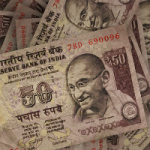 “Federal Reserve Rates and INR Reverse Carry”. As we understand that Federal Reserve Chairman Janet Yellen turning Hawkish and asking for 25 Bps increase in September 2016. If we look carefully then Fed vice Chair Fisher also suggested the same and at the same time most prominent Bond Trader – Bill Gross also suggested increase of 25 Bps in September and 25 Bps in December. If this would happen then Overnight Rates of USD would move to 1% and this would be closer to Australia which is 1.5% in $ terms.
“Federal Reserve Rates and INR Reverse Carry”. As we understand that Federal Reserve Chairman Janet Yellen turning Hawkish and asking for 25 Bps increase in September 2016. If we look carefully then Fed vice Chair Fisher also suggested the same and at the same time most prominent Bond Trader – Bill Gross also suggested increase of 25 Bps in September and 25 Bps in December. If this would happen then Overnight Rates of USD would move to 1% and this would be closer to Australia which is 1.5% in $ terms. Rahul Magan – Chief Executive Officer Treasury Consulting LLP
Rahul Magan – Chief Executive Officer Treasury Consulting LLP


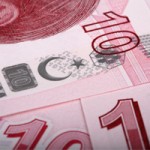
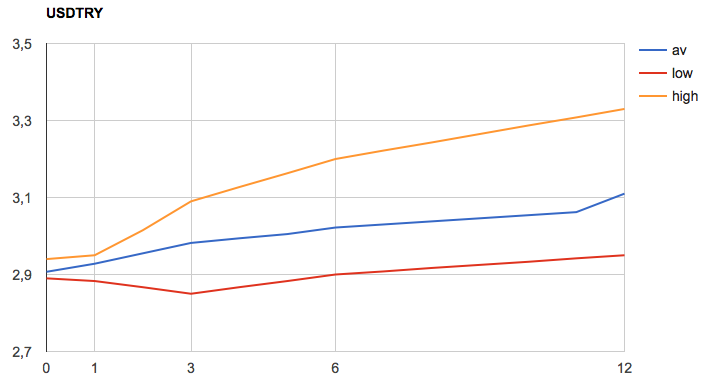


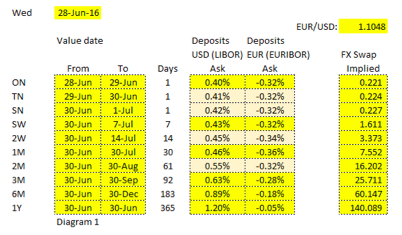 Now if we would consider exchanging a USD deposit versus a EUR deposit for 1 year the cash flows would be as follows:
Now if we would consider exchanging a USD deposit versus a EUR deposit for 1 year the cash flows would be as follows: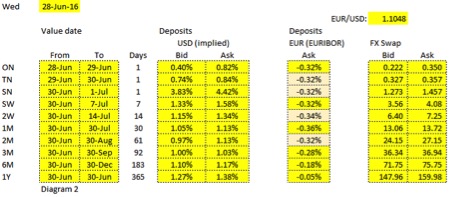 e are looking at a single day FX swap, the annualized rate could swing a lot.
e are looking at a single day FX swap, the annualized rate could swing a lot.
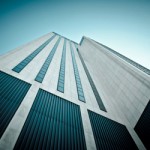 Today in Rob Söentken’s Option Tales: When buying options it is tempting to see if the premium expenses can be minimized. A number of solutions are possible, which will be discussed in four articles. In the
Today in Rob Söentken’s Option Tales: When buying options it is tempting to see if the premium expenses can be minimized. A number of solutions are possible, which will be discussed in four articles. In the  bought the option for 1.5%, we could sell it after 3 months at 1.1% and buy the USD through an outright forward transaction. This approach shows that the net cost of option protection would be only 0.4% (1.5% – 1.1%). Which would be cheaper than the premium of a 3-month option with the same Delta. Also, because the option has a higher Delta than a 3-month option with the same strike (25% vs 10%, see diagram 2), it will follow the spot market much better. The bottom line of paragraph 3 is that a longer dated option can be bought with the intention to sell it again at some point, the net cost being less than buying a shorter dated option. While it serves as a hedge against price changes.
bought the option for 1.5%, we could sell it after 3 months at 1.1% and buy the USD through an outright forward transaction. This approach shows that the net cost of option protection would be only 0.4% (1.5% – 1.1%). Which would be cheaper than the premium of a 3-month option with the same Delta. Also, because the option has a higher Delta than a 3-month option with the same strike (25% vs 10%, see diagram 2), it will follow the spot market much better. The bottom line of paragraph 3 is that a longer dated option can be bought with the intention to sell it again at some point, the net cost being less than buying a shorter dated option. While it serves as a hedge against price changes. buy the 1-year option in diagram 2 for 1.5%. Alternatively we could consider buying a right to buy this option for 0.4% in 3 months time. At that time the 1-year option will only have 9 months remaining, but the strike and 1.5% premium are fixed in the contract. On the expiry date of the compound option we can decide if we want to pay 1.5% for the underlying option. Alternatively, assuming nothing has changed, we could buy a 9 month option in the market for 1.1% (see diagram 2). In such a case we wouldn’t exercise the compound option.
buy the 1-year option in diagram 2 for 1.5%. Alternatively we could consider buying a right to buy this option for 0.4% in 3 months time. At that time the 1-year option will only have 9 months remaining, but the strike and 1.5% premium are fixed in the contract. On the expiry date of the compound option we can decide if we want to pay 1.5% for the underlying option. Alternatively, assuming nothing has changed, we could buy a 9 month option in the market for 1.1% (see diagram 2). In such a case we wouldn’t exercise the compound option.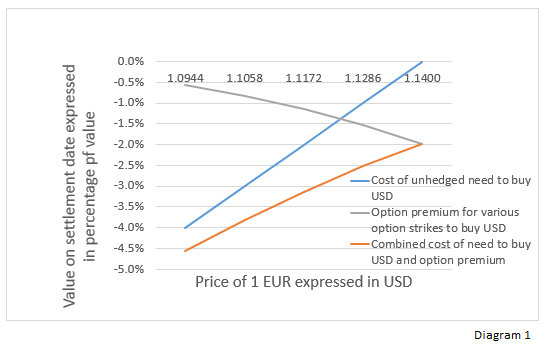
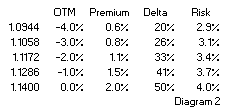 Risk appears fairly stabile across strikes, which makes sense because the premiums are calculated with one volatility on one underlying. The Risk on OTM is lower than that for ATM options. It appears that OTM premiums are relatively more expensive, they give protection against less potential loss.
Risk appears fairly stabile across strikes, which makes sense because the premiums are calculated with one volatility on one underlying. The Risk on OTM is lower than that for ATM options. It appears that OTM premiums are relatively more expensive, they give protection against less potential loss.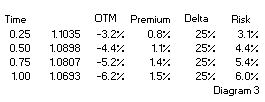 Diagram 3 shows Premiums, Delta and Risk for different tenors. ‘Time’ is the time to expiry of the options in fractions of years. Its shows that for longer tenors, the Risk is higher. But disproportionally. For the same chance on exercise a hedger could double the premium to buy a hedge for a 4x longer tenor.
Diagram 3 shows Premiums, Delta and Risk for different tenors. ‘Time’ is the time to expiry of the options in fractions of years. Its shows that for longer tenors, the Risk is higher. But disproportionally. For the same chance on exercise a hedger could double the premium to buy a hedge for a 4x longer tenor.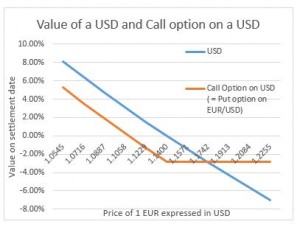 Diagram 1 explains his feelings. I assume he was considering only the left half of the payoff diagram. After an appreciation of the USD, a USD is always worth more than a call option on a USD, the difference being the option premium.
Diagram 1 explains his feelings. I assume he was considering only the left half of the payoff diagram. After an appreciation of the USD, a USD is always worth more than a call option on a USD, the difference being the option premium.